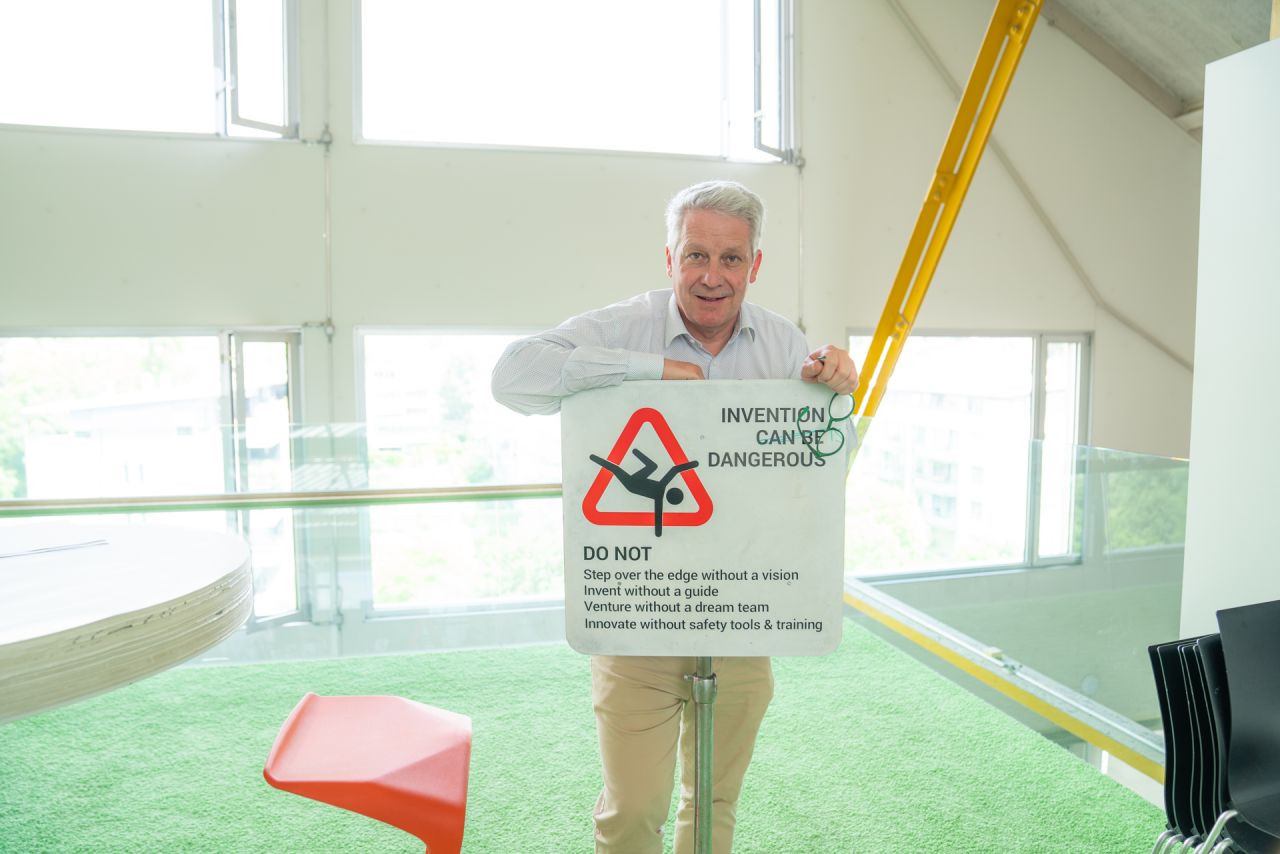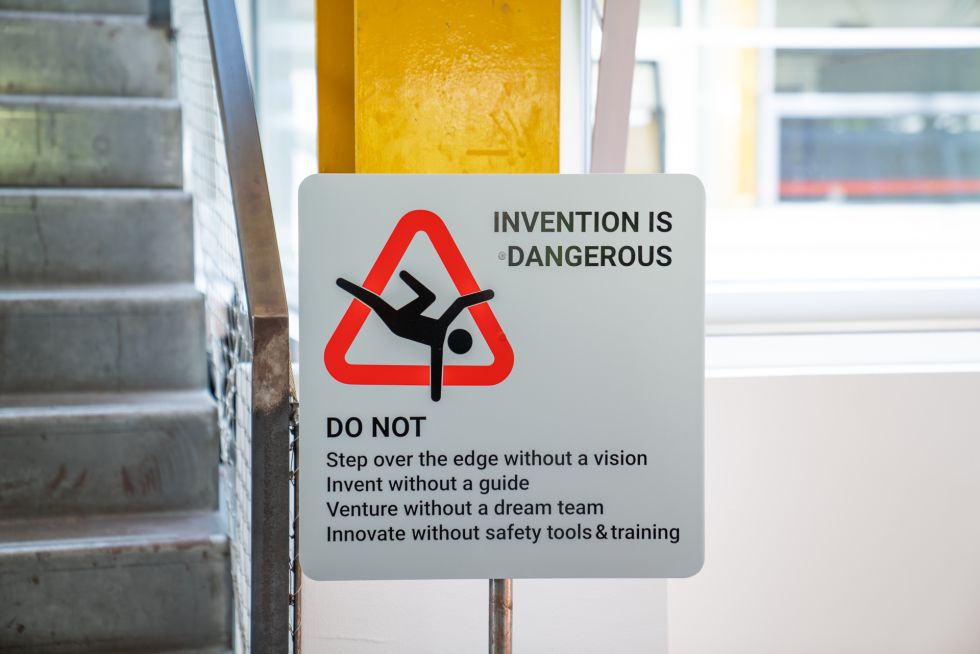
News «Man muss die Fähigkeit haben, das Unterbewusstsein zu füttern»
Interview and photography: Stefan Jermann
Picasso once said that every child is an artist, and the problem is how to remain an artist once we grow up. Does the same hold true for innovation? Would we all be more innovative if we paid more attention to our inner child?
Childlike curiosity and playfulness definitely help, but creativity is only one side of the coin. In order to develop successful innovations, you must above all have a feel for the market and a passion for entrepreneurship.
Can one learn to be an inventor?
I believe so. Many people have a sense of innovation, but it can and must be cultivated. Here at Creaholic, we exercise this sense every day, because it is our passion. After all, you cannot become a good skier without practice.
How important is the “eureka” moment?
Usually there is not just a single final “eureka!”, but many. In retrospect, one frequently focuses on the single most inspired idea that leads to a groundbreaking innovation, but a successful product is usually based on many decisive moments. And always, a wide variety of people are involved, not just one ingenious mind.
So innovation means teamwork?
I come up with my best ideas when I am lying alone in bed thinking – but only if I have discussed the ideas intensively with my team beforehand. You have to have the ability to feed your subconscious, and that is only possible if you have a great team. One could say that the idea must be inspired by the team. As the ancient Greeks said: Good ideas require the inspiration of a muse. At Creaholic, we are all muses that inspire each other.
What role do doubts play in this?
The best inventors are skeptics. Ideas are rarely truly good right from the start, most of them are not fully matured and must be critically scrutinized. Being innovative requires the confidence to pursue your own path, but you also need to be sufficiently self-critical to keep questioning your path.
And what about failure? It strikes me that mistakes are frowned upon in Switzerland, whereas in the US, for example, the attitude towards failure is much more relaxed. What is your experience?
That is indeed the case. The Swiss are very tenacious when it comes to turning an idea into a success. The downside of this is that sometimes, it takes us too long to admit our mistakes. At Creaholic we also had first to learn, to learn from our mistakes. We are better at it today than we used to be.
Is there a formula for developing solutions to problems?
There are literally thousands of books on innovation, and each one claims its own method is the only correct one. They sometimes remind me of all those diet books. The key is to know which method is best suited for the current situation.
What method do you apply?
We have developed our own approach; the “Gas-Liquid-Solid” mindset. Based on this, our innovations are created in three phases: In the gas state, the molecules are free and ideas can be thought up from scratch. In the liquid phase, the ideas condense into a feasible concept, and in the solid mode, we create the actual solution. The gas state is the most important. Figuratively speaking, this is where the chair molecule meets the dynamite molecule – combined, this results in the idea of the ejection seat. If you always think of the chair as furniture, you would never come up with such a concept.
In your opinion, what are the three most important factors for the launch of a successful product?
For me, market demand ranks first and competitiveness second. In my opinion, the technological ingenuity of the product is only the third priority, despite the fact that I have an engineering background.
Christina Taylor from Creaholic recently published a book on Human-Centered Design (HCD). What lies behind this concept?
Many people assume that technology lies at the heart of innovations and the needs of the customer are often overlooked. HCD is based on the philosophy of developing products and services based on a rigorous customer-centric perspective. First and foremost, this means that the innovation must offer customers relevant solutions. Apple is a prime example of this approach: Their products feel good and are easy to use. Of course, profitability should not be overlooked either. In our opinion, the most effective innovation is achieved by focusing on these three aspects – customer needs, profitability, and technology.
How do you find out what the customers really want? Or in other words: What is more important, satisfying an existing need or creating new needs?
Frequently that is not the key question, unfortunately. Many companies approach us with concrete ideas, which we always examine in detail. Our task is to find out whether the idea actually addresses a customer need. Examining needs and their context is an important part of the innovation process.
And how is it possible to make the customer feel at home?
By creating a pleasant experience. The shops of the Swiss telecommunications provider Swisscom are a good example of this. They used to be rather cold and sterile. Today the interior resembles a homely kitchen. Trying out products in a relaxed atmosphere is a much more pleasant experience for the customer than simply standing in front of a shelf.
Zurück zum Beispiel Apple: Warum bringt dieses einst so innovative Unternehmen heute kaum noch Innovationen hervor?
Ich glaube, dass es für grosse Unternehmen grundsätzlich sehr schwierig ist, disruptive Innovationen auf den Markt zu bringen.
Warum?
Wenn man den Mount Everest besteigt, dann fühlt man sich wohler in einem kleinen Team als in einem grossen. Genau so ist es in der Produktentwicklung. Unternehmen wie das unsrige erlauben es grossen Firmen, Innovationen in überschaubaren Teams zu entwickeln.
Viele Unternehmen wollen agiler werden. Geht das innerhalb der althergebrachten Strukturen und Hierarchien überhaupt?
Nein. Wer agile Prozesse etablieren will, muss dazu bereit sein, alte Strukturen aufzubrechen. Aber es muss auch nicht jeder Unternehmenszweig agile Strukturen einführen. Bei Produktions- oder Logistikprozessen zum Beispiel sehe ich eher Nachteile.
Sie arbeiten mit Unternehmen aus verschiedensten Branchen zusammen. Wie gross sind dabei die Unterschiede?
Sie werden immer kleiner, denn die verschiedenen Wirtschaftszweige verschmelzen zunehmend. Ein Fahrzeug zum Beispiel hat heute auch eine Kommunikationsfunktion und ein Lebensmittel einen Gesundheitsaspekt.
Die Kunden von Bystronic sind mehrheitlich Lohnfertiger. Wie können diese in einer globalisierten Welt konkurrenzfähig bleiben?
Es geht darum, besser zu sein als die anderen. Mit besser meine ich vor allem den intelligenten Umgang mit Daten und Know-how. Speziell im westeuropäischen Raum, wo es nicht nur um den Preis geht, scheint mir das wichtig.
Wie stehen Sie der Digitalisierung gegenüber? Ist das für Sie eine rein positive Entwicklung oder sehen Sie auch negative Aspekte?
Ich bin der Digitalisierung gegenüber zu 100 Prozent positiv gestimmt, insbesondere, weil dadurch zeitraubende manuelle Prozesse automatisiert werden. Ich denke, wir können diese Zeit sinnvoller einsetzen. Natürlich hat jede Technologie auch ihre Schattenseiten: Man kann eine Smartwatch nutzen, um ein Date zu vereinbaren oder einen Terroranschlag zu verüben. Zum Glück nutzt aber die grosse Mehrheit neue Technologien in positiver Absicht.
Man hört immer wieder, dass das Tempo heute höher sei als früher und dadurch auch der Druck. Teilen Sie diese Meinung?
Die Neandertaler standen wahrscheinlich deutlich mehr unter Druck als wir. Sie mussten sich vor wilden Tieren schützen und ständig ums Überleben kämpfen. Ich denke oft, dass wir in der Schweiz zu wenig Druck haben. Es geht uns einfach sehr gut, und das macht uns auch bequem. Die Coronakrise sorgt aktuell für etwas mehr Druck. Ich hoffe, dass wir dies für positive Veränderungen nutzen können.
Was haben Sie aus der Krise gelernt?
Früher bin ich oft stundenlang gereist, um ein Meeting abzuhalten. Heute weiss ich, dass das nicht unbedingt nötig ist.
Gibt es eine Erfindung, die Sie gerne noch machen würden?
Das Beamen. Ich denke, das könnten wir alle gut gebrauchen.





